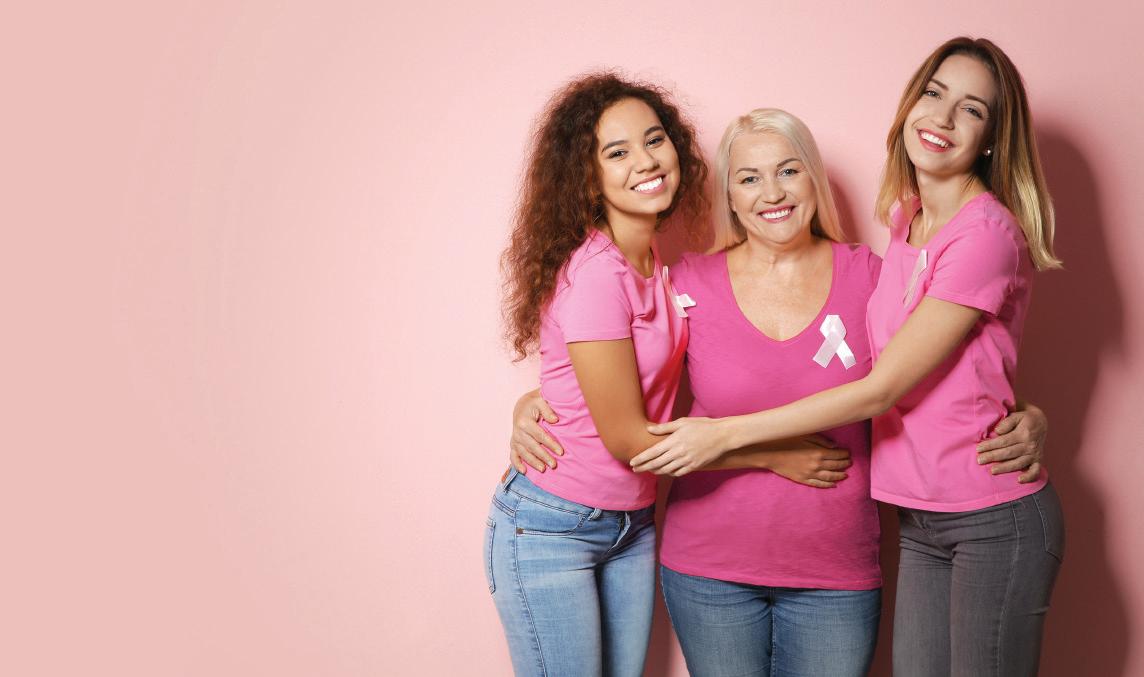
4 minute read
Breast Assured
By Natasha Kubis
October is Breast Cancer Awareness Month, and a good time to get acquainted with the anatomy of your breasts, as well as the best practices for cancer prevention. Sadly, 1 in 8 women will be diagnosed with breast cancer in her lifetime, and it is a significant health threat. Other conditions that can affect the breasts, and are often benign, are cysts and fibrocystic changes. Infections of the breast tissue can also occur, particularly during breastfeeding, and mastitis, or inflammation of the breast, is common.
Advertisement
With the right knowledge, you can take preventative measures and a proactive approach to your breast health. Here’s how:
Schedule Your Mammogram A mammogram scans breast tissue for tumors or other abnormalities that might be a sign of breast cancer, and is typically performed for the first time when a woman is between 40 and 50 years old. Women should have a repeat scan every 1-2 years. Menopausal women often have dense breast tissue, and density can obstruct cancer detection through a mammogram, making it unreliable, so 3-D ultrasound is recommended in these cases.
Report Any Breast Changes You should be familiar with the way your breasts normally look and feel. You should report any of the following changes to your doctor: a change in the look or feel of the breast and nipple, which can include a change in size, dimpling, swelling, shrinking, asymmetry of either the breasts or nipples, or a discharge from the nipple.
Quit Smoking Smoking is associated with an increased risk of breast cancer, particularly among women who started smoking at adolescent or peri-menarcheal ages. Cigarette smoke contains 3,000 types of carcinogens that could potentially affect your health.
Limit Alcohol
A meta-analysis of 53 studies showed that women who drank more than 3 drinks a day had 1.5 times the risk of developing breast cancer than nondrinkers. Try to keep it to 1 serving a day or less: 12 ounces of beer, 5 ounces of wine, or 1.5 ounces of hard liquor.
Stay at a Healthy Weight Fat cells produce estrogen and high levels of that hormone have been linked to certain cancers. Working out can shrink the size of fat cells, so your body pumps out less estrogen. The American Cancer Society recommends getting at least 150 minutes of moderate intensity exercise per week.
Eat Your Fruits and Veggies Eat at least 5 servings of fruits and vegetables every day. Several recent studies have suggested that eating a lot of fruits and veggies may be associated with a lowered risk for developing estrogen-receptor-negative breast tumors. The effect may be due to the fact that plant foods tend to be rich in carotenoids, natural pigments that often serve as antioxidants. Estrogen-receptor-negative breast cancers make up only about 15 percent of all breast cancers, but they're particularly hard to treat. The USDA advises that you should fill half your plate with produce. In addition it is best to avoid refined, heavily processed foods, and added sugars. There have been numerous studies on the benefits of plant based diets and decreased cancer risk.
Get Rest and Reduce Stress
Both of these practices help the body heal by repairing cellular damage and inflammation. Shoot for 7-8 hours of good sleep and try to incorporate techniques for relaxation, such as yoga and meditation.
Indulge in Some Chocolate Chocolate contains a phytochemical compound called flavonoids. A flavonoid is an antioxidant that can prevent or slow damage to cells caused by free

radicals, thereby potentially assisting in the prevention of cancer. Of course, moderation is the key.
Get Adequate Amounts of Folic Acid
Not eating enough folate, the naturally occurring form of folic acid, is linked with impaired ability to repair DNA, and damaged DNA has been linked to cancer. Folate is found in foods such as spinach, black-eyed peas, folic-fortified cereals, and grains. Try to get 400 micrograms daily.
FUN FACTS ABOUT BREASTS
Both males and females have breasts. The structure of the male breast is nearly identical to that of the female breast, except that the male breast tissue lacks the specialized lobules, as there is no physiologic need for milk production by the male breast (although there have been some documented instances of male lactation).
Our breast size is constantly changing. You might notice that your breasts shrink when you lose weight. That is because your breasts are made of fat. Pregnancy, breast-feeding, menopause, birth control pills, and even sex can cause your breasts to swell. Your breasts can also grow as much as a full cup size during your menstrual cycle. However, days after your period, your hormone levels drop and your bustline is at its smallest.
We are the only primates with permanent breasts. As humans, we grow breasts before puberty even starts, and they continue growing and changing throughout our lives. Other primates' breasts grow only when they are breastfeeding.
The average breast weighs between 1-2 pounds. Breasts are not twins, they are sisters. Two breasts are rarely, if ever, identical. Breasts are a wonderful, life nourishing part of our anatomy. It is important to pay close attention to our diet and lifestyles for sustained breast health and wellness.
Natasha Kubis is a licensed acupuncturist and certified yoga teacher. For more information, visit
acuwellhealth.com





